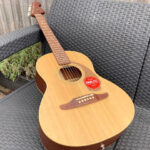Like many guitar enthusiasts, my fascination with guitars was ignited by watching the Beatles on the Ed Sullivan Show in 1964. Huddled close to the television screen, I was captivated, trying to decipher the brand name on John Lennon’s guitar headstock – Rickenbacker? A name unfamiliar at the time. George Harrison’s Gretsch Country Gentleman was recognizable, while Paul McCartney’s Hofner bass was undeniably unique. The Beatles, it seemed, had access to any guitar imaginable, sparking my lifelong interest in their instrument choices. While none of the Fab Four famously wielded a Gibson Es 335 Guitar, their affinity for semi-hollow guitars is well-documented, particularly with their use of Epiphone Casinos.
The Epiphone Casino, much like the Gibson ES-330, presented challenges at high volumes due to feedback. For a band like the Beatles, known for pushing sonic boundaries, managing feedback was crucial, beyond the controlled feedback intro of “I Feel Fine.” Interestingly, during the mid-60s, I myself was playing a guitar from the same family as their Casinos – a ’63 ES-330. However, there’s a lesser-known Gibson ES model with a Beatle connection: George Harrison’s sunburst stoptail ES-345.
Sometime in 1965, George acquired this ES-345 and began playing it onstage in November of that year. It became his primary stage guitar after a mishap involving his second Gretsch Country Gentleman and a tour van. The ES-345 in question appears to be a late ’63 or ’64 model. It wasn’t uncommon for high-end guitars, especially in the UK, to be purchased a year or two after their production date. Although the Beatles toured extensively in 1965, including the iconic Shea Stadium performance, the ES-345 didn’t make its stage debut until late in the year.
The Beatles’ final British tour in December 1965 saw George initially using his second Gretsch Country Gentleman. However, following the unfortunate “lorry” incident, the ES-345 was brought out and used for the remainder of the tour, alongside his Rickenbacker 12-string. After the tour concluded around Christmas, George’s ES-345 vanished from the public eye. Its whereabouts remain unknown, but I like to imagine it might have crossed my path at some point over the years.
Photos of George with his ES-345 are scarce. In the few available, like the one above, George appears deeply engrossed in his playing. Perhaps, as the original article humorously suggests, he was appreciating the nuanced tone of the Varitone circuit in this particular ES-345, a feature often debated among guitarists for its impact on the guitar’s sound.
Intriguingly, another photo surfaces, seemingly showing George with a long guard dot neck Gibson. However, this guitar belonged to Joe Brown of Joe Brown & the Bruvvers, who the Beatles opened for in 1963. This image, captured by Paul’s brother Michael, highlights the era’s vibrant guitar scene and the shared instruments among musicians. The story of George Harrison’s Gibson ES-345 adds a fascinating chapter to the Beatles’ guitar history, reminding us that even amidst their iconic instruments, there were lesser-known gems that played a part in their legendary sound.
Please note: While the article focuses on the Gibson ES-345 due to its connection to George Harrison, readers interested in the broader family of semi-hollow guitars may find value in exploring the renowned Gibson ES 335 guitar, a model celebrated for its versatility and iconic status in music history.

